
This is an artist’s rendering of a cosmic-ray air shower with a water-Cherenkov detector of the Pierre Auger Observatory in western Argentina. Credit: A. Chantelauze, S. Staffi, L. Bret.
A massive international collaboration more than 12 years in the making has struck gold. Astronomers working with the Pierre Auger Observatory located in the Argentinian desert claim the most energetic cosmic rays in the known universe don’t originate from within the Milky Way. We still don’t know what exactly triggers them or even what they’re made of but this breakthrough provides solid footing that might one day enable scientists to unravel one of the most mysterious forces in the cosmos.
Somewhere, a source is spewing the most intense radiation ever
Cosmic rays are high-energy radiation composed of atomic nuclei. They were first detected in 1912 but many things about them that still remain mysterious despite more than a century since their discovery. One such conundrum is their origin.
We do now know that highly energetic cosmic events such as a supernova can generate atomic fragments like protons, electrons, and atomic nuclei. The problem is by the time they reach Earth, it’s nearly impossible to pinpoint the source.
Every second, our planet’s atmosphere is bombarded by thousands of such particles where they collide with other atoms. Almost none reach the ground. What touches the planet’s surface though are so-called ‘secondary particles’, which form in the aftermath of cosmic rays colliding with molecules from the upper atmosphere. A secondary particle will create a new charged particle once it again collides with atmospheric molecules and so on in a cascade which scientists call a cosmic-ray air shower. This is how we’ve been able to indirectly detect cosmic rays.
Cosmic rays come in different varieties, too. One particular kind of cosmic rays called “Ultra High Energy Cosmic Rays” (UHECR) is thought to carry particles with the highest energy we’ve ever seen. Only one atomic nucleus has enough energy as a tennis ball flung at 100mph. That’s mindbogglingly in the order of quintillions of electronvolts or sixty times more energy than the Large Hadron Collider (LHC) can produce. To accelerate particles to the same kind of energy, the LHC would have to be made out of a ring more than 70 million miles in diameter. Comprehending the scale involved is really a stretch of the imagination.
Stirring water
Whatever’s producing these esoteric UHECRs must be extremely intense. We don’t know what yet but thanks to the diligence of hundreds of scientists from 18 countries working with the Pierre Auger Observatory, the shroud is getting thinner.
What makes UHECrs particularly elusive is they rarely reach Earth’s atmosphere. It’s thought that on average one square kilometer of the upper atmosphere is hit by just one single such energetic particle every century. Practically, it’s impossible to detect a UHECR — unless you know how to read secondary particles.
That’s the whole premise on how the Pierre Auger base was built in the remote, flat plains of the Mendoza province, Argentina. Over an area as large as Rhode Island (3,100 square kilometers), there are some 1,600 particle detectors installed. Each detector is made out of a water tank only a couple meters across. When the particles hit the water, an electromagnetic shock is produced that tingles light-detecting tubes mounted on the tank.
After 12 years of, well, mostly waiting, researchers reported in the journal Science that UHECRs don’t originate from within the Milky Way. They learned this fact after plotting the distribution of all the high-energy particles they could count. Instead of appearing uniformly across the night’s sky, there seemed to be a preferential direction.
Even so, things aren’t clear at all yet. Because the atomic nuclei are charged particles, their direction of motion is influenced by the galactic and intergalactic magnetic fields. What’s more, we still don’t know what’s emanating such intense radiation.
What we now know though is where to look — and that’s far, far more than we know before this paper was published.
“We are now considerably closer to solving the mystery of where and how these extraordinary particles are created — a question of great interest to astrophysicists,” said University of Wuppertal Prof. Karl-Heinz Kampert, spokesperson for the Auger Collaboration, in a press release. “Our observation provides compelling evidence that the sites of acceleration are outside the Milky Way.”










